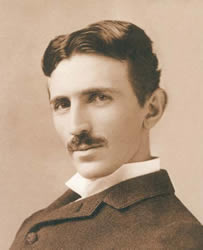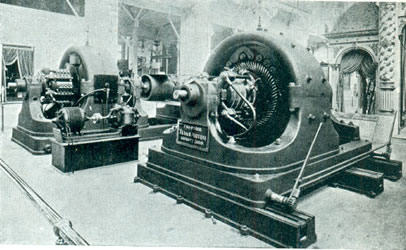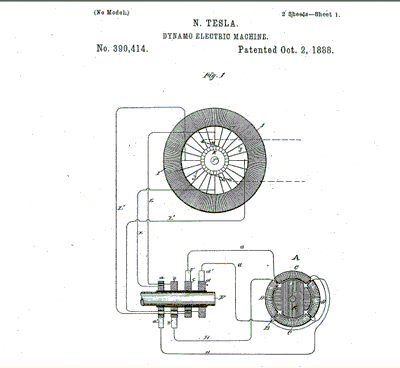Nikola Tesla (1856)

Source: Wikimedia Commons (Public Domain)
Nikola Tesla was born in 1856 in Austria-Hungary and emigrated to the U.S. in 1884 as a physicist. He pioneered the generation, transmission, and use of alternating current (AC) electricity, which can be transmitted over much greater distances than direct current.
Tesla patented a device to induce electrical current in a piece of iron (a rotor) spinning between two electrified coils of wire. This rotating magnetic field device generates AC current when it is made to rotate by using some form mechanical energy, like steam or hydropower. When the generated current reaches its user and is fed into another rotating magnetic field device, this second device becomes an AC induction motor that produces mechanical energy. Induction motors run household appliances like clothes washers and dryers. Development of these devices led to widespread industrial and manufacturing uses for electricity.
The induction motor was only part of Tesla's overall conception. In a series of history-making patents, he demonstrated a polyphase alternating-current system, consisting of a generator, transformers, transmission layout, and motor and lights. From the power source to the power user, it provided the basic elements for electrical production and utilization. Our AC power system remains essentially unchanged today.

Source: Wikimedia Commons (Public Domain)
In 1888, George Westinghouse, head of the Westinghouse Electric Company, bought the patent rights to Tesla's system of dynamos, transformers and motors. Westinghouse used Tesla's alternating current system to light the World's Columbian Exposition of 1893 in Chicago. Then in 1896, Tesla's system was used at Niagara Falls in the world's first large hydroelectric plant. The Tesla coil, invented in 1891, is still used in radio and television sets, car starters, and a wide variety of electronic equipment.
Tesla's work with radio-frequency waves laid the foundation for today's radio. He experimented with wireless transmission of electrical power, and received 112 patents for devices ranging from speedometers to extremely efficient electrical generators to a bladeless turbine still in use today. He suggested that it was possible to use radio waves to detect ships (later developed as RADAR), and his work with special gas-filled lamps set the stage for the creation of fluorescent lighting.
Tesla was Thomas Edison's rival at the end of the 19th century - in fact, he was more famous than Edison throughout the 1890's. His invention of polyphase AC electric power earned him worldwide fame but not fortune. At his zenith his circle of friends included poets and scientists, industrialists and financiers. Yet Tesla died alone and almost penniless in a New York hotel room in 1943. During his life, Tesla created a legacy of genuine invention that still fascinates today. After his death, the world honored him by naming the unit of magnetic flux density the "tesla."
Clicking on this image will take you from the EIA Kid's Page to the U.S. Patent and Trademark Office's Patent Full-Text and Image Database. When you get there, you will need to click on the box that says "Image" in order to access the patent. When coming "back", you might need to double-click your "back" button.



